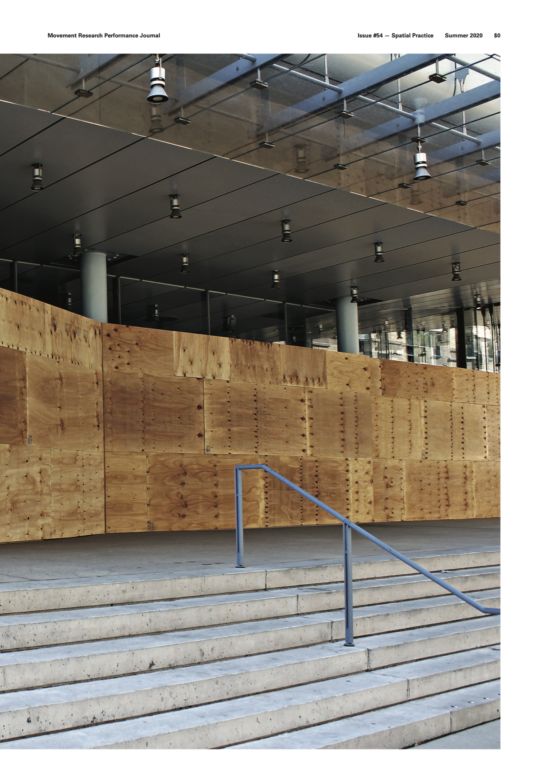Issue #54
Summer 2020

Movement Research announces Issue 54 of its publication, the Movement Research Performance Journal. Continuing to experiment with approaches that engage contemporary choreography and performance through the medium of print—poem, prose, image, interview and a wide range of formats give form to critical and self-reflexive discourses and material histories. Movement Research Performance Journal acts as a site of convergence between publication, editors, writers, designers, and artists to consider the place of dance, performance, and choreography in relation to the contemporary moment.
For MRPJ54: Spatial Practice, guest editor, artist Alan Ruiz invited contributors to examine the ongoing legacy of neoliberalism and the cultural production it engenders, specifically focusing on the relation between bodies and the built environment. Contributors have explored the contexts and histories in which we dwell, create, and coexist to interrogate how space is produced both as material and ideology during the hyper-development and hyper-exploitation of the urban environment, predominantly in New York City. Spatial Practice asks: how does this impact the bodies that labor and move to keep the kinetic machine of “progress” moving? Contributions offer multiple perspectives—through a variety of genres—on the ways in which the political project of neoliberalism has, in part, shaped the designation and use of public space as well as enthroned the philanthropic class and the cultural institutions associated with them. Alongside the consolidation of wealth and power, neoliberalism’s underlying insistence on individualism has also reinforced and normalized the braided conditions of capitalist exploitation, structural racism, and patriarchal domination. Unraveling this logic allows us to collectively imagine alternatives to the prevailing systems of property, dispossession, ableism, and incarceration that parcelize existence.
Within Spatial Practice, a separate section dedicated to dance includes submissions culled from the performance community tied into the larger thematic architecture of the issue, but meant to stand alone. These works range from descriptions of the politics and ethics of various art works to which the writers bore witness or take the form of dialogues about practices and philosophies of the role and perception of art and artists in self-reflexive essays and tributes. Some artists share scores and visual essays to elucidate their creative process, institutional critique, and political sentiments. Also included are edited transcripts from interviews about creating techniques and practices around embodied and disembodied notions of performance as well as discussions around the importance of probing the hierarchies created by white supremacy in spaces of dance-making, dance pedagogy, and auditions. This collection of creators, scholars, and figures in the field of movement enrich the very focused discussion of Issue 54 to incorporate voices from the community. This section of the Performance Journal functions as an open and expanded container—not assembled through theme-based content, but through incidental and sometimes concurrent concerns.
The release of MRPJ54 coincides with the convergence of the COVID-19 pandemic and the political actions taken by Black Lives Matter and abolitionists across the world. This moment has demanded that the world take pause and consider the multiple precarities and conditions under which bodies operate and are assigned value in society. The built environment is not merely a backdrop for these questions but, as many of MRPJ54’s contributors suggest, is constitutive of an apparatus of political forces. These forces shape the built-environment—and yet, how we perform against urban and social infrastructures (especially those that reinforce existing structures of power) can be understood as a fundamental dimension of ongoing agonistic struggles. Protest does more than take to the street—it takes it over and rewrites the protocols of space. Many activists and scholars have long argued for the importance of mass demonstration in the struggle for social transformation and that neoliberalism and carceral capitalism are both expressions of the same underlying system of exploitation and oppression. Included in Issue 54 is material by the grassroots organization Critical Resistance—founded by Angela Davis, Ruth Wilson Gilmore, Rose Braz, and others—that is dedicated to dismantling the prison-industrial complex. Critical Resistance’s “Abolitionist Toolkit” is reprinted as the interior cover to MRPJ54: Spatial Practice and a chapter from Angela Davis’s Are Prisons Obsolete? is reprinted as the interior cover to MRPJ54: Performance Journal. The wrapped cover of MRPJ54: Spatial Practice depicts the shuttered entrance to the Whitney Museum of American Art, which—like several other prominent New York City museums and hundreds of businesses—responded to civic unrest by denying its capacity to function as a public space. As a counterpoint, the MRPJ54: Performance Journal section’s wrapped cover depicts the opened entrance to New York Theatre Workshop, which was one of several arts organizations participating in the #OpenYourLobby initiative by functioning as sites of refuge during weeks of protests. Rather than simply a container, these examples reveal how the built environment is a necessary site for both action and critique.
Editorial team
Alan Ruiz - Natalia Flores Zalles - Juli Brandano - Nadia Hannan - Barbara Bryan - Sarah Michelson
Editor-In-Chief
Moriah Evans
Managing Editor
John Arthur Peetz
Associate Editor
Emily Bartsch
Ad Layout
Kate Reilly